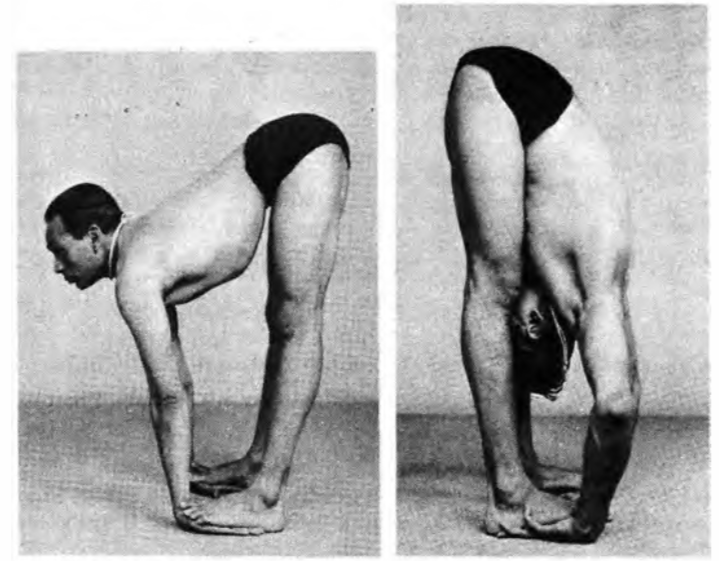What are you looking for?
Padangusthasana & Padangusthasana
Padangusthasana – 3
Pada means the foot. Angustha is the big toe. This posture is done by standing and catching the big toes.
Technique
1 . Stand in Tadasana, spread the legs a foot apart.
2. Exhale, bend forward and hold the big toes between the thumbs and the first two fingers, so that the palms face each other. Hold them tight.
3. Keep the head up, stretch the diaphragm towards the chest and make the back as concave as possible. Instead of stretching down from the shoulders, bend forward from the pelvic region to get the concave shape of the back from the coccyx.
4· Keep the legs stiff and do not slacken the grip at the knees and toes. Stretch the shoulder-blades also. Take one or two breaths in this position.
5· Now exhale, and bring the head in between the knees by tighten ing the knees and pulling the toes without lifting them off the floor. Remain in this pose for about 20 seconds, maintaining normal breathing.
6. Inhale, come to position 2 , release the toes and stand up. Return to Tadasana.
Techniques
1 . Stand in Tadasana, spread the legs a foot apart.
2. Exhale, bend forward and without bending the legs at the knees insert the hands under the feet so that the palms touch the soles.
3· Keep the head up and make the back as concave as possible. Do not slacken the grip at the knees and take a few breaths in this position.
4· Now exhale, and move the head in between the knees by bending the elbows and pulling the feet up from the palms. (Plate 46.) Stay in the pose for about 20 seconds with normal breathing. .
5· Inhale, raise the head and come back to position 2 (Plate 45), with the head well up. Take two breaths.
6. Inhale, stand up and return to Tadasana.
Effects
The second asana is more strenuous than the first, but the effects of both are the same. The abdominal organs are toned and digestive juices increase, while the liver and spleen are activated. Persons suffer ing from a bloating sensation in the abdomen or from gastric troubles will benefit by practicing these two asanas. Slipped spinal discs can only be adjusted in the concave back position· Do not bring the head in between the knees if you have a displaced disc. I have experimented with persons suffering from slipped discs and the concave back position proved a boon to them. It is imperative to get guidance from a guru (master) before trying this pose, because it may not be possible to achieve the concave back position immediately. One has to master other minor poses before attempting this one.

